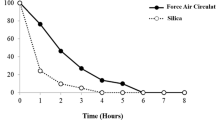Abstract
The fractions of apoplasmic water of six moss species were estimated by comparison of the osmotic potentials of fully turgid living tissues (Ψ π(s)) and of killed shoots (Ψ π(k)). The values of Ψ π(s) were determined by pressure-volume analysis using thermocouple hygrometry, whereas those of Ψ π(k) were obtained by cryoscopy using extracts produced from dried materials and taking into consideration the original saturation water content of the shoots. Most of the tissues had Ψ π(s) values around-1 to -1.5 MPa and non-osmotic water fractions of roughly 20% of the total water content at full turgor. Quantitative analysis of a number of osmotically active cell constituents showed that about one-third of the osmotic potential resulted from the accumulation of sugars. The total free amino acids accounted for about 15–20% of the osmolality of the cell solution. Malic- and citricacid contents varied much more with species but, in general, both carboxylic acids together contributed nearly 10–20% to the osmotic potential. The contents of inorganic anions such as free chloride and phosphate in mosses were low.
Similar content being viewed by others
Abbreviations
- Ψ π(s) :
-
symplasmic osmotic potential of living tissue at full turgidity
- Ψ π(k) :
-
osmotic potential of water-saturated killed tissue
- P-V:
-
pressure-volume
- R:
-
relative water content
- Ra :
-
apoplasmic water as a fraction of total water content
References
Andersen, M.N., Jensen, C.R., Lösch, R. (1991) Derivation of pressure-volume curves by a non-linear regression procedure and determination of apoplastic water. J. Exp. Bot. 42, 159–165
Augé, R.M., Schekel, K.A., Wample, R.L. (1986) Osmotic adjustment in leaves of VA mycorrhizal and nonmycorrhizal rose plants in response to drought stress. Plant Physiol. 82, 765–770
Augé, R.M., Stodola, A.J.W., Pennell, B.D. (1990) Osmotic and turgor adjustment in Rosa foliage drought-stressed under varying irradiance. J. Am. Soc. Hort. Sci. 115, 661–667
Bates, L.S., Waldren, R.P., Teare, I.D. (1973) Rapid determination of free proline for water-stress studies. Plant Soil 39, 205–207
Beeson, R.C. Jr, Montano, J.M., Proebsting, W.M. (1986) A method for determining the apoplastic water volume of conifer needles. Physiol. Plant. 66, 129–133
Bergmeyer, H.U., ed. (1974) Methoden der enzymatischen Analyse. Verlag Chemie, Weinheim, Germany
Busby, J.R., Whitfield, D.W.A. (1978) Water potential, water content, and net assimilation of some boreal forest mosses. Can. J. Bot. 56, 1551–1558
Campbell, G.S., Papendick, R.I., Rabie, E., Shayo-Ngowi, A.J. (1979) A comparison of osmotic potential, elastic modulus, and apoplastic water in leaves of dryland winter wheat. Agron. J. 71, 31–36
Cortes, P.M., Sinclair, T.R. (1985) Extraction of apoplastic water during pressure-volume dehydrations. Agron. J. 77, 798–802
Dilks, T.J.K., Proctor, M.C.F. (1979) Photosynthesis, respiration and water content in bryophytes. New Phytol. 82, 97–114
Duggan, E.L. (1957) Measurement of amino acids by column chromatography. Methods Enzymol. 3, 492–504
Hegnauer, R. (1962) Chemotaxonomie der Pflanzen, vol. 1. Birkhäuser, Basel Stuttgart
Hegnauer, R. (1986) Chemotaxonomie der Pflanzen, vol. 7. Birkhäuser, Basel Boston Stuttgart
Maass, W.S.G., Craigie, J.S. (1964) Examination of some soluble constituents of Sphagnum gametophytes. Can. J. Bot. 42, 805–813
Margaris, N.S. (1974) Free amino acid pools of certain mosses from Greece. Bryologist 77, 246–247
Richter, H., Duhme, F., Glatzel, G., Hinckley, T.M., Karlic, H. (1981) Some limitations and applications of the pressure-volume curve technique in ecophysiological research. In: Plants and their atmospheric environment (The 21st symposium of the British Ecological Society Edinburgh, 1979), pp. 263–272, Grace, J., Ford, E.D., Jarvis, P.G., eds. Blackwell Sci. Publ., Oxford
Rütten, D., Santarius, K.A. (1992) Relationship between frost tolerance and sugar concentration of various bryophytes in summer and winter. Oecologia 91, 260–265
Rütten, D., Santarius, K.A. (1993a) Osmotic potentials of watersaturated mosses. J. Plant Physiol. 141, 739–744
Rütten, D., Santarius, K.A. (1993b) Seasonal variation in frost tolerance and sugar content of two Plagiomnium species. Bryoogist 96, 564–568
Santakumari, M., Berkowitz, G.A. (1989) Protoplast volume: water potential relationship and bound water fraction in spinach leaves. Plant Physiol. 91, 13–18
Scholander, P.F., Hammel, H.T., Hemmingsen, E.A., Bradstreet, E.D. (1964) Hydrostatic pressure and osmotic potential in leaves of mangroves and some other plants. Proc. Natl. Acad. Sci. USA 52, 119–125
Scholander, P.F., Hammel, H.T., Bradstreet, E.D., Hemmingsen, E.A. (1965) Sap pressure in vascular plants. Negative hydrostatic pressure can be measured in plants. Science 148, 339–346
Shacklette, H.T. (1965) Element content of bryophytes. US Geol. Surv. Bull. 1198-D, 1–21
Suire, C. (1975) Les données actuelles sur la chimie des Bryophytes. Rev. Bryol. Lichénol. 41, 105–256
Taussky, H.H., Shorr, E. (1953) A microcolorimetric method for the determination of inorganic phosphorus. J. Biol. Chem. 202, 675–685
Tyree, M.T., Richter, H. (1981) Alternative methods of analysing water potential isotherms: some cautions and clarifications. I. The impact of non-ideality and of some experimental errors. J. Exp. Bot. 32, 643–653
Tyree, M.T., Richter, H. (1982) Alternative methods of analysing water potential isotherms: some cautions and clarifications. II. Curvilinearity in water potential isotherms. Can. J. Bot. 60, 911–916
Urban, L., Jaffrin, A., Chraibi, A. (1993) Analysis of pressurevolume curves of leaves of Rosa hybrida cv. Sonia. J. Exp. Bot. 44, 605–613
Vos, J., Oyarzún, P.J. (1988) Water relations of potato leaves. II. Pressure-volume analysis and inferences about the constancy of the apoplastic fraction. Ann. Bot. 62, 449–454
Walland, A., Kinzel, H. (1966) Über die Zusammensetzung der Zellsäfte bei Archegoniaten. Flora 156, 597–633
Author information
Authors and Affiliations
Additional information
The author is very obliged to Mr. Rainer Franzen for capable technical assistance and to Mrs. Dr. Dorothea Rütten for placing some of the material to our disposal. The critical reading of the manuscript by Prof. Dr. R. Lösch, Institute of Ecological Plant Physiology and Geobotany, University of Düsseldorf, is gratefully acknowledged.
Rights and permissions
About this article
Cite this article
Santarius, K.A. Apoplasmic water fractions and osmotic potentials at full turgidity of some Bryidae. Planta 193, 32–37 (1994). https://doi.org/10.1007/BF00191603
Received:
Accepted:
Issue Date:
DOI: https://doi.org/10.1007/BF00191603




